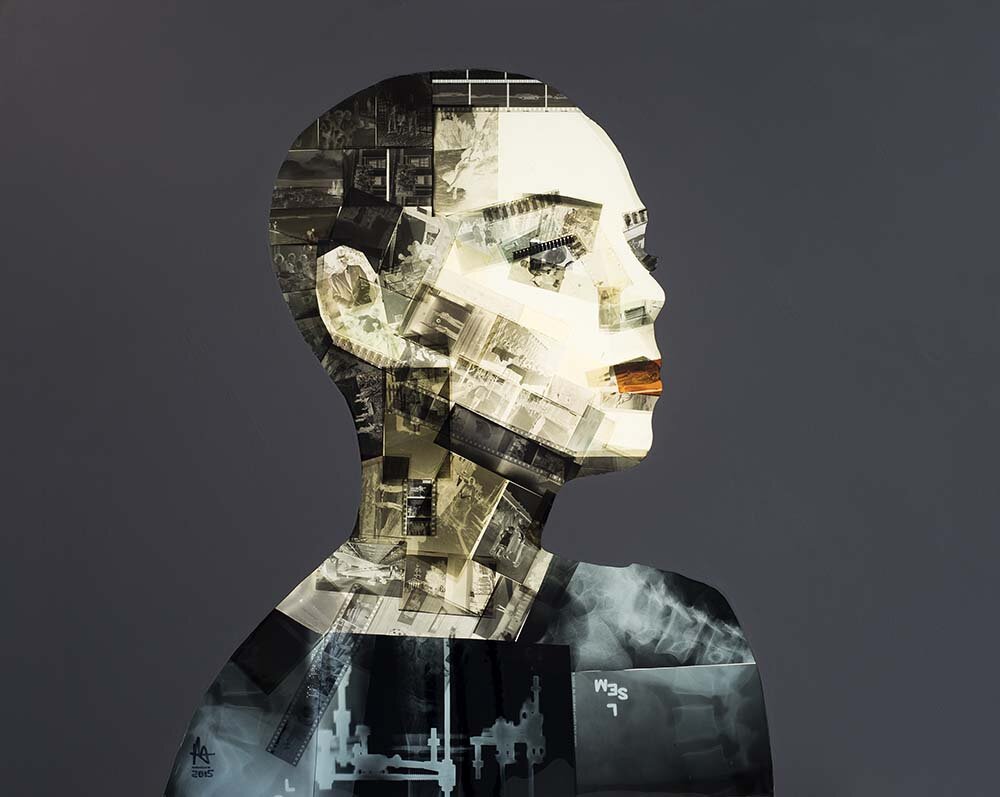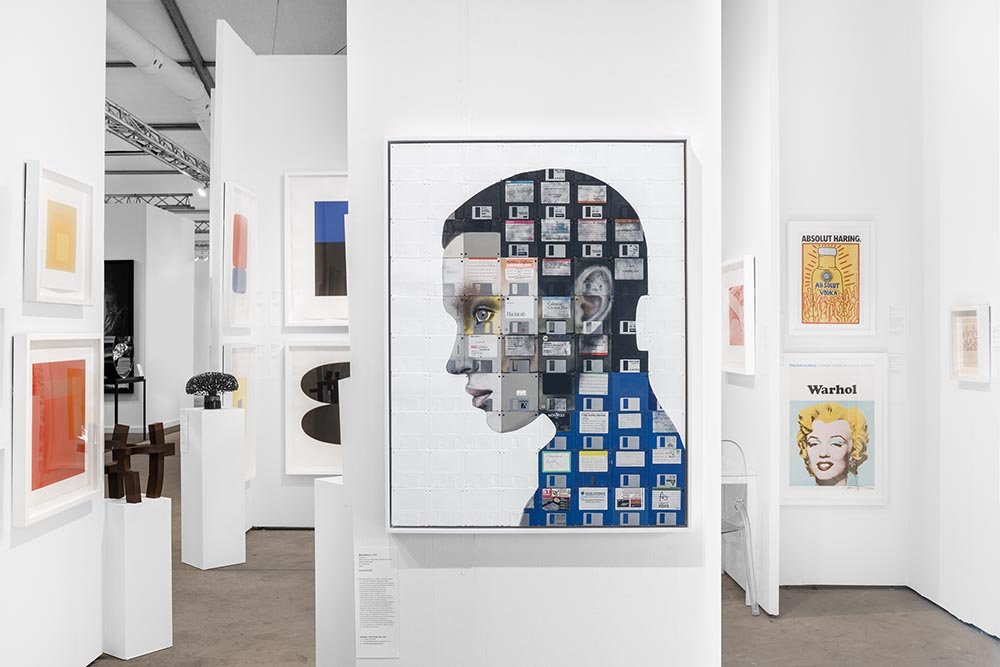Memoryscapes
Solo show
Absolute Art Gallery, Belgium
2015
Meeting with Konbini: Nick Gentry sublimates his paintings with photographic equipment
Halfway between painting and sculpture, Nick Gentry's hybrid works exploit photographic material as an art in its own right
Nick Gentry , complete artist, handles the brush as well as the chisel and the camera. Hybrid, his work brings together a set of portraits he paints, often representing women, known or not.
He then finishes each of his works with photographic material which he cuts and assembles. The pieces of film and negatives thus become a creative ground for his paintings, which he exploits from top to bottom.
During an interview with this open-minded artist, we asked him to tell us about his inspirations and his values, from film photography to the digital era, but also from social networks and his most dreams. crazy. Meet a man full of imagination.
Konbini | Can you introduce yourself? What is your background?
I spend most of my time painting portraits, but I don't just define myself as a painter. I always want to adapt and evolve over time. I studied at Central Saint Martins College of Arts and Design in London and, even if it was enriching and formative, I still consider myself a self-taught.
I think the most important lessons come from elsewhere, at different times in our lives, far from the pressure and formality of the academic environment.
How would you define your work?
I prefer not to define my work, or things in general. My feeling is that as soon as something is defined and categorised, it can lose the rawness that made it interesting at first. For now, I'm happy to embrace the mystery and let the viewer interpret my work as they wish.
Can you give us your references and your inspirations?
I am inspired by absolutely everything. Nothingness could even be a source of inspiration for me. Normally, the further your sources of inspiration are from art, the better. There are already far too many arts that inspire artists.
When there are references, that's fine, but you have to be careful not to repeat what has already been done. I am interested in many different things like yoga, gastronomy, technology, cinema, travel, literature, nature, and I just started playing the piano.
It is important to push the limits of the mind in other directions and to nourish it with other things. Leonardo da Vinci understood this well. He is probably the greatest source of inspiration: I like the way he simply experiences nature and life. He then describes all of these elements artistically and personally through unique, varied and incredible forms.
What is your favourite moment in creating a project?
In the creation process, each step is different and good. But the one I prefer is the finishing of the last details. This has something satisfying, if everything goes as planned, of course! What I like are the little moments that punctuate an achievement. For me, there is no better time than these little "waves of consciousness".
Your approach is very creative because you use photographic material for a completely different artistic genre: painting. How did you come up with this idea?
I have observed how photography is changing during the digital revolution we are going through. Of course, these technological developments have repercussions on the whole world, but I have the feeling that photography is at the origin of this change.
When we look at Instagram, we notice that 100 million photos and videos are shared every day on this platform. It is a process and a scale that are so vast and so rapid that it seems to me unimaginable.
Can you imagine telling yourself what is going to happen in the world of photography to someone who lived twenty years earlier? Can we understand and reflect on what goes beyond our understanding?
The evolution and sharing of photography could constitute one of the most important cultural levers ever known, and we have barely entered this new era.
So, from a historical point of view, getting rid of modest negatives and dandruff could constitute the act of destroying a simple obsolete plastic. But I, in my works, see them as sources of information and blocks of colour.
I can transform them and give them new life, make these films solid and new by assembling forgotten, neglected and disparate parts.
What types of materials do you use?
I collected all types of negatives in large and medium formats, films from the beginning of the 20th century to the iconic 35mm reel that could be found in the 1980s and 1990s. I also use film from 8 mm and 16 mm, as well as microfilm. All these materials are sent to me by strangers: linked by this approach, we are building something unique together.
Why do you add all these negatives to your paintings? Are they not enough? Does this add anything special that your paintings cannot express?
I think the combinations are a unique power and mode of expression. Nothing can exist by self-sufficiency. I want to explore and celebrate the links that unite the arts, not what separates them. In a sense, these associations provide a reason for dandruff to exist. They are abstract and can only be deciphered by approaching them. From afar, they completely change shape and find their meaning in each portrait.
What do you think of film photography (as opposed to digital)? By using film, do you want to pay tribute to this photographic tradition or perpetuate its use?
I'm not trying to get a message across; I must remain neutral to let the spectator imagine what he wants and reflect on his own interpretations and feelings in front of the work. I don't want to "contaminate" her experience by saying too much. I love the silver formats, they have something real, tangible, that you can feel and hold in your hands. Even if sometimes, what we prefer, are the binary sequences of 1 and 0, and speed: in a word, numeric.
What do you think of all these applications dedicated to photography (Instagram, VSCO, etc.)? Do they distort photographic art in your opinion, or are they a good thing? How do you use social media for your artistic practice?
I use Instagram to share my work with as many people as possible and to face the harsh reality: most people will discover my art in miniature on an Instagram account rather than in a gallery.
I think artists today have to get used to this multi-format challenge. The attention of people is reduced, the subtle works which require a certain time of contemplation are abandoned in favour of images more obvious to understand and to look at.
We must ensure that we do not prefer quantity to quality. The algorithm is now set by the curator, who very often tends to favour impact and virality in a minimum of time. The quarter of an hour of celebrity mentioned in his time by Andy Warhol now seems to have shortened to 15 milliseconds.
Is there a guideline, themes or values that come up in each of your projects?
What obsesses me is time. It is a concept that we do not fully grasp. I'm not talking about the moving needle but the real essence of passing time, the feeling of change. Everyone thinks of their life and the time they have left. This mysterious awareness is something that makes humans unique. So, in a way, I'm trying to understand these basic questions: who we are and how we use our time.
What is the craziest project that you would like to realise one day or that you would have liked to do?
I love what JR does with photography. It is bold and intelligent. People around the world can identify and gravitate around his work. It really captures the era we live in, incorporating the fact that people want to see themselves through art.
Have any artists recently caught your attention?
I recently discovered Conor Harrington , Adam Neate , James Clar and Robert Del Naja (the founding member of the Massive Attack group , editor's note ).
Future projects?
I have just been exhibited at the C24 Gallery in New York. I'm back in London and I plan to do another exhibit next year. Regarding new perspectives, I already have some collaborations in mind.
“The great parallel is that a portrait is a snapshot in time while disks and negatives also capture a specific moment. This combination brings a greater sense of permanence to his art.”














